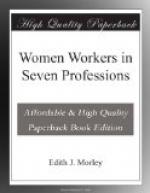The most varying reports are given as to the incomes to be made in private practice and it is almost impossible to get at the truth, because it is obviously to everybody’s interest to make them appear as high as possible. A woman’s practice also is admittedly rather a specialist one. She does not get the general local practice of the ordinary practitioner, but instead certain selected women who want to consult a member of their own sex. These often live at considerable distances, thus making the work more difficult to arrange and the travelling more expensive than in the case of the ordinary medical man. It is rare for a woman to be able to buy a practice. She must generally build it up for herself, as it is of little or no use for her to buy a man’s practice, and there are only very few women’s available.
Generally, it may be stated that a woman covers her expenses by about the third or fourth year after starting, and she may ultimately make, according to the district and her success, anything between L400 and L1,500 a year. Frequently two medical women settle together, which seems to be a very good arrangement.
(c) If she elect to enter the public service her outlay is very small. Beyond equipping herself for this work in certain special branches already described, all that is necessary is that she should be able to keep herself until she obtains a suitable post. The salary given for whole time work in the public service should not be less than L250 a year rising to L400 or L500 a year. In most cases the school doctor gets the school holidays, including the whole of every Saturday.
English women who go to India, do so generally in connection with either
(1) a missionary society, or
(2) a hospital under the Dufferin
Fund.
(1) Many missionary societies engage medical women to treat the native women. Salaries, of course, differ, but are, on the whole, low, as the aim of a missionary is not supposed, primarily, to be financial gain. Generally somewhere about L110 in English money is given, with an allowance for carriage and house including the chief items of furniture. Leave is also granted with second class return fare every five years—in some missions every three years. The medical experience is excellent, the opportunities of doing good professional work are practically unlimited, and the professional position of the doctor quite untrammelled. She is assisted, usually, by good nurses, under a proper scheme, these being Indian girls superintended by fully trained English sisters.
(2) Under the Dufferin Fund[2] things are very different. It is somewhat difficult to speak of this branch of the work, as it is, at the present time, the subject of enquiry, and it may be legitimately expected that it will, before long, be put on a more satisfactory basis. The fund was originally started by Lady Dufferin as the direct result of a command by the late Queen Victoria, and it was intended to provide




